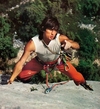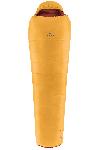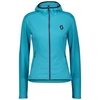Colin Haley, mountain climbing from Alaska to Patagonia
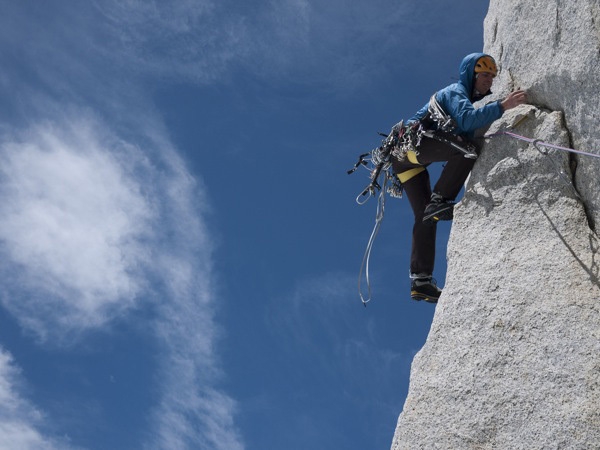
 1 / 9
1 / 9 Mikey Schaefer
Mikey Schaefer
There are few climbers who have amassed such a remarkable climbing resume as American alpinist Colin Haley. Remarkable for the sheer quantity of routes climbed, impressive for the style in which many were carried out: first ascents, solo, first winter ascents, fast and light, from Alaska to Patagonia, via the Andes and the Alps. All of these climbs, the most important of which are listed below, were done in a mere nine years of climbing. What is clear is that the 26-year-old from Washington has made alpinism, alpine style, his way of living and interpreting the mountains. So much so that he migrates north in summer and south in the winter, across the American continent in instinctive search for the ideal line, to be climbed in perfect style. One example of this is the coveted first-ever Torre Traverse, climbed with Rolando Garibotti in a moment of true determination and inspiration. While there can be no doubt the enchainment served as a springboard to international recognition amongst his peers, it is equally clear that the climb wasn't a one-hit wonder, rather, it was the result of years of climbing hard, and fair, in the mountains. In this exclusive interview, Haley dissects his alpinism and sheds light on the raw elements which have made it his raison d'être.
For many Colin Haley equals Patagonia. How true is this?
Well, it certainly is true that Patagonia is a large part of who I am, but I am not a large part of what Patagonian climbing is. Patagonian climbing is represented by people such as Jose Luis Fonrouge, Casimiro Ferrari, Ermanno Salvaterra, Silvo Karo, Janez Jeglic and Rolando Garibotti. I plan to keep climbing in Patagonia for a long time though, and I feel like I've only just begun, so maybe someday I will feel like a part of Patagonian climbing. Also, I think I have done almost as much significant climbing in Alaska as I've done in Patagonia, so Alaskan climbing is also a large part of who I am.
So tell us about your Alaska.
Alaska is full of good alpine-climbing objectives. There are many impressive faces that are still waiting for first ascents, and many of the mountains are truly on the same scale as the Himalaya. Also, for a climber in the US or Canada it is much less expensive and much easier to travel to Alaska than to Nepal, China, India or Pakistan. I personally have made two climbs in Alaska that I think are as good as my best efforts in Patagonia. One was in 2006, with Jed Brown, when we made the first ascent of a wall on Mt. Moffit that we named ¨The Entropy Wall¨ (VI, 5.9, A2, WI4+) It was very remote, a very big face (over 2,000 meters), and a very technical wall. It didn´t see very much media coverage, because few people have heard of Mt. Moffit and few people had heard our names at the time, but it remains one of the best routes I have done.
And what about the second climb
My other best climb in Alaska was this past year, when Bjorn-Eivind Artun and I made the first ascent of a new route ¨Dracula¨ (VI, AI4+, M6R) on the southeast face of Mt. Foraker. It had difficult climbing, and was enormous (3,000 meters of elevation on route).
Routes like these certainly don't come from nowhere. How did you get into climbing? And was it clear from the outset that you'd be taken in by alpinism?
I have been hiking and backcountry skiing in the mountains all my life, but I first started climbing technical mountains when I was eleven years old with my dad and my brother. All my early climbs were in boots and with a swami belt [webbing wrapped around the waist]. I had already been a climber for a few years when I bought my first harness and rock shoes. Although I now rock climb quite a bit, I was an alpine climber from the beginning and this remains my focus - to me it was always obvious that the mountains interested me the most.
Who are your mentors?
I have had two main mentors in my climbing. The first is a friend from home named Mark Bunker. We started climbing together when I was seventeen years old. Although I was young, I was extremely motivated so I made a decent partner. Mark had been doing winter climbing and expeditions in Alaska for years, so I was able to learn a lot from him. More than anyone else, Mark taught me the skills needed to tackle big, serious, multi-day alpine routes. The other main mentor I've had is Rolando Garibotti. Rolo is the most talented climber I have ever roped up with. The chance to climb the Torres Traverse with him was the sort of good fortune that no amount of money could buy. I have learned a lot from Rolo, not just in terms of climbing skills, but I also enjoy learning climbing history from him, which he is quite a scholar of!
Talking of Garibotti: at the very latest you achieved international recognition with the Torre Traverse which you climbed with him. In retrospect, how important was that climb?
The first ascent of the Torres Traverse was far and away the best climb I have ever done. There is no doubt that Rolo was the driving force behind that climb, and he did most of the leading, but it was such a fantastic climb that even my lesser role was definitely my best climbing accomplishment. I am comfortable with the fact that I might never in my life make a climbing accomplishment better than the first ascent of the Torres Traverse. There are no other mountains on the planet like these ones. I simply was in the right place at the right time with the perfect partner.
Conditions are the key to success
Yes, but I don't think it was very dangerous at the time. Compared the danger of serac avalanches I have witnessed in Alaska and the Himalaya, the danger on the Torres Traverse was not bad at all.
How do you choose your projects?
There is no simple algorithm to explain which objectives interest me, but there are some generalizations. More than anything else, I don't like the climbing to feel contrived. I don't like to be on a hard route on an otherwise easy face. If the route I am on is difficult, but I know that I can just traverse to the left or right to find easier terrain then it makes the experience a bit silly. Similarly, I am not interested in free ascents in the big mountains, because this is also a contrived difficulty.
Which means...
To me, the perfect climbing experience is a completely unclimbed mountain, that is extremely difficult to climb on any of its flanks. The experience does not feel very contrived if your goal is simply to get to the summit by any route in alpine style.
Yes, but mountains are three-dimensional, the various faces offer different challenges
Yes, even if the other side of the mountain is easy to climb, you can have a very real experience if you climb a very difficult face. Let me put it in other words: it feels much less contrived to climb the easiest route on a difficult face than the most difficult route on an easy face. For example, if you climb the Walker Spur it does not feel contrived because the north face of Les Grandes Jorasses is an impressive face, and traversing to the left or right from the Walker Spur would only put you on more difficult terrain. In this sense, the Walker Spur is a very beautiful and natural line. The Cassin Ridge on Denali is another perfect example.
It wouldn't surprise me if you could give us opposite examples...
On the other end of the spectrum are routes such as the Gabarrou-Silvy on Aiguille Sans Nom, which, although I'm sure it has great climbing on it, is intentionally finding a difficult line on a face that is not that difficult to climb by its natural lines. An example of a similar route in Alaska is "The Knowledge" on the North Buttress of Mt. Hunter, which, although it is a very impressive climb, is intentionally finding more difficult variations to an easier and more natural line (The Bibler-Klewin).
So: the easiest line up an unclimbed mountain.
Yes, but I really like routes that involve lots of different types of climbing difficulties. I think it is great if, for the same route, you need to bring rock shoes and you need to bring technical ice tools and crampons. The Torres are perfect for this, with almost all the routes involving both difficult rock climbing and difficult ice and mixed climbing.
Tell us about the style
To me, good style just means no fixed ropes to the base of the face - once you start up, you don't go back down until you've either finished the route or bailed. Pure alpine style is of course the most impressive, but even capsule style is much more impressive than a string of fixed ropes to the base of the face.
How do you define alpine style?
Alpine style climbing means a small group of climbers (normally two or three, maybe as many as four) heading up the face with just two or three climbing ropes among them. Maybe they will fix ropes above a good bivouac ledge, but that is the extent of fixed ropes. One misconception I think many people make is that alpine style means no haulbags or portaledges, but of course you can climb alpine bigwalls in alpine style - Silvo Karo and Janez Jeglic made the first ascent of the West Face of Bhagirathi III in alpine style with a portaledge, and I think it is one of the greatest ascents of all time.
Anything else?
Well it goes without saying that bolts should only be placed where there are no cracks, used to a bare minimum and drilled by hand.
Many of your ascents are carried out alone.
Solo alpine climbing can be a very powerful experience. I'm not anti-social at all, and most of the time I prefer climbing with a partner, but it is a great challenge to climb by yourself. To walk to the base of a big, difficult mountain, and look up the face, planning to get to the summit by yourself, is very intimidating. To put it very simply, climbing solo in alpine style is the most challenging experience you can make for yourself on a route.
You've spent months of your life waiting for right weather window. How do the days unfold?
Patagonia isn't really an expedition anymore, since we stay down in El Chalten now. You can go bouldering, go sport climbing, go hiking, eat pizza, hang out with cute girls, etc... Anyone who complains about the waiting in El Chalten obviously hasn't done much expedition climbing in Alaska or the Himalaya.
Is patience your biggest virtue?
My biggest virtue? I don't think so. Perhaps I'm more patient than some, but I'm no zen master.
You mentioned El Chalten a moment ago. Not all too long ago climbers hung out beneath the Torre for months, now everyone waits downtown...
Yes, the experience of a Patagonian climbing trip has changed a lot since my first visit to the massif in 2003. There are a lot of advantages to living down in El Chalten now compared to living up in a basecamp like we used to do - in town you can stay in better climbing fitness with all the bouldering and sport climbing, you can eat a healthier diet with plenty of fresh fruit and vegetables available, and you can simply stay more entertained with a large community of cool people.
Still, though, sometimes it makes me sad how radically the place has changed and how many people are here now. Sometimes I long for the old experience, and wish the tourism explosion would slow down here. But there's nothing you can do to stop it, so there's no choice but to accept it as inevitable. Another change here that makes me sad is the rapid climate change. There is no doubt in my mind that the average annual temperature in the Fitz Roy massif has increased since my first trip here, and the rate of de-glaciation going on is insane. I have seen some sections of the Torre Glacier drop about 100 meters in altitude in five years!
There has been a significant rise in successful ascents in Patagonia in recent years. Can this be put down to the change in the weather pattern?
In recent years there have been many more climbers here than in the past, so there have of course been more ascents of the smaller peaks and the via normales on peaks such as Fitz Roy. But I think it is still only once every few years that a really impressive climb gets accomplished here.
For many Patagonia is akin to Cerro Torre and Fitz Roy. Surely it is much more than just these two?
For someone coming to Patagonia for the first time, I of course suggest to start out with smaller objectives. To me it is very obvious that when you visit a new mountain range for the first time you don't start out trying the big objectives. On my first trip to Patagonia I climbed Aguja de la S, Aguja Guillaumet, and Aguja Poincenot, which gave me enough experience in the range that on my second trip I felt comfortable climbing Fitz Roy, which gave me enough experience that on my third trip I felt comfortable climbing Cerro Torre. Nonetheless, Fitz Roy and the Torres are of course the most amazing peaks here!
Last question: will we be seeing your sights set on other mountain ranges in the near future?
I don't think so. In the past few years I have made a semi-regularly annual schedule of Patagonia, the Alps, Alaska, the Cascades, the Karakorum, Yosemite, and then Patagonia again... In any one of these ranges are a lifetime of worthy, inspiring things to climb, and I'm certainly not bored with any of them! I have been making almost back-to-back climbing trips for a few years, and there simply isn't time to fit in another mountain range unless I take out one of the ranges I'm already visiting and love.
Colin Haley in 2010 soloing Aguja Mermoz via the Argentine Route (600m, 6a+, Héctor Cuiñas, Guillermo Vieiro and Fermín Olaechea, 1974)
| Planetmountain | |
| News Colin Haley | |
| Expo La Sportiva | |
| Expo Black Diamond | |
| www | |
| colinhaley.blogspot.com | |
Colin Haley – Climbing Resume as of 2011
Patagonia
-Aguja St. Exupery. Kearney-Harrington (V, 5.10). Jan 2011.
-Aguja Mermoz. Jardines Japoneses (V, 5.10, AI4, A0), first ascent. Dec 2010.
-Aguja Guillaumet. Brenner Ridge (IV, 5.10). Dec 2010.
-Cerro Standhardt. Exocet (VI, 5.10, WI5), first solo ascent of Cerro Standhardt. Nov 2010.
-Aguja Mermoz. West Face (V, 5.10, AI3), second solo ascent. March 2010.
-Aguja Guillaumet, Aguja Mermoz, Fitz Roy. The Care Bear Traverse (VI, 5.10, A1), fourth ascent. Feb 2010.
-Aguja Guillaumet. Amy Route (IV, 5.9, AI3), solo ascent. Dec 2009.
-Aguja Poincenot. Whillans Route (V, 5.8, AI3), solo ascent. Dec 2009.
-Fitz Roy. Supercanaleta (VI, 5.10, WI4). second solo ascent. Jan 2009.
-Aguja Guillaumet, Aguja Mermoz, Fitz Roy. The Care Bear Traverse (VI, 5.10, A1), second ascent. Dec 2008.
-Fitz Roy. Afanasief Route (VI, 5.10). Jan 2008.
-Cerro Standhardt, Punta Herron, Torre Egger, Cerro Torre. The Torre Traverse (VI, 5.11, A1, AI6), first ascent. Jan 2008.
-Aguja Desmochada. Huber-Walder Route (V, 5.10). Dec 2007,
-Fitz Roy. Supercanaleta (VI, 5.10, WI4). Dec 2007.
-Cerro Standhardt. Exocet (VI, 5.10, WI6). Dec 2007.
-El Mocho. Todo O Nada (IV, WI6). Dec 2007.
-Cerro Torre. Tiempos Perdidos (VI, WI4, M5, AI6, 1400m), first complete ascent. January 2007.
-Aguja Rafael. Anglo-American (IV+, 5.10+). Dec 2005.
-Aguja St. Exupery. Ciaro di Luna (V, 5.10+). Dec 2005.
-Fitz Roy. Franco-Argentine (V+, 5.11, AI3). Dec 2005.
-Aguja Mermoz. West Face (V, 5.10, AI3). Dec 2005.
-Aguja Guillaumet. Comesana-Fonrouge (IV+, 5.10). Dec 2005.
-Aguja de la S. Austrian Route (IV, 5.10). Dec 2003.
-Aguja Guillaumet. Amy Route (IV, 5.9, AI3). Dec 2003.
-Aguja Poincenot. Whillans Route (V, 5.8, AI3). Dec 2003.
Alaska
-Devil's Thumb. The Diablo Traverse (VI, 5.11, A2), first ascent. Aug 2010.
-Mt. Foraker. Dracula (VI, M6, AI4+, A0), first ascent. June 2010.
-Denali. Messner Couloir, West Buttress, and Cassin Ridge (VI, M4+, AI3), 17 hr. simul-solo. June 2010.
-Mt. Hunter. Grison-Tedeschi (VI, AI5+, M5, A1), fourth ascent. May 2009.
-Denali. West Buttress, Upper West Rib, and Denali Diamond (VI, WI5+, M6, A1). June 2007.
-Abercrombie Peak. Southwest Face (V, WI4, M3), first ascent. March 2007.
-Mt. Huntington. Nettle-Quirk Route (V, AI4), first winter ascent of Huntington. March 2007.
-Mt. Moffit, Hayes Range. The Entropy Wall (VI, 5.9, A2+, WI4+, 2400m), first ascent. July 2006.
-Denali. West Rib. June 2005.
-Denali. West Buttress. June 2003.
Canada
-Mt. Robson, BC. House-Haley Route (VI, WI5, M7) first ascent. May 2007.
-Mount Andromeda, AB. The Andromeda Strain (V, 5.9, A2, AI3), winter ascent. March 2005.
-Mount Robson, BC. North Face (IV, AI3), solo. August 2004.
-Waddington Range Enchainment, BC. Second ascent (VI, 5.9, AI3). July 2004.
-North Howser Tower, BC. All Along the Watchtower (VI, 5.10, A2). July 2004.
-Blackhorn Mountain, BC. Northwest Face (IV+, AI3), first ascent, solo. Sept 2003.
Cascades
-Mt. Stuart. Lara Kellogg Memorial Route (IV, WI6, A1), first ascent. April 2007.
-Mt. Index. The Index Peak Traverse (V, AI3, 5.7), one day winter ascent. January 2007.
-Chiwawa Mountain. Intravenous (IV, WI4+, M6), first ascent. Feb 2005.
-Mount Triumph. Northeast Ridge, first winter ascent (V, AI3, M4). Feb 2005.
-Mount Stuart. Complete North Ridge, first winter ascent (VI, 5.8, AI3, A2). Feb 2005.
-The Chopping Block. First winter ascent, solo. Feb 2004.
-Southern Picket Range Enchainment. First ascent (VI, 5.10+, 14 Peaks). July 2003.
-Inspiration Peak. First winter ascent. Feb 2003.
-Johannesberg Mtn. NE Buttress (V, 5.5), second winter ascent. Dec 2002.
-Graybeard Peak. North Face (IV+, AI4), second ascent, solo. May 2002.
Elsewhere
-Mont Blanc du Tacul, Chamonix, France. Supercouloir (V, AI5, 5.8) solo. April 2010.
-20-hour linkup of the Regular NW Face of Half Dome and The Nose of El Capitan, Yosemite. Oct 2009.
-Les Doites, Chamonix, France. Le Ginat (IV, AI5, M3), solo ascent in 3:26. April 2009.
-Aiguille Verte, Chamonix, France. Couturier Couloir (III, AI3), one-hour ascent solo ascent. April 2009.
-Les Doites, Chamonix, France. Colton-Brooks (IV, AI4, M4). April 2009.
-Les Courtes, Chamonix, France. Swiss Route (IV, AI3), solo. March 2009.
-Les Grandes Jorasses, Chamonix, France. Colton-MacIntyre (V, AI5, M5). March 2009.
-Baintha Kabata (6,000m), Pakistan. Turgeon-Haley Route (V, 5.9, M5, A0), first ascent of Baintha Kabata. September 2008.
-Les Doites, Chamonix, France. Lagarde Couloir (IV+, AI4). April 2006.
-Aiguille Du Midi, Chamonix, France. Chere Couloir (IV, AI3), solo. Feb 2006.
-Drifika (6,447m), Pakistan. Solo attempt on new route to 10m below summit. Sept 2005.
-Nanga Parbat, Pakistan. Solo attempt to 6,500m on Schell Route. Sept 2005.
-Alpamayo, Peru. Ferrari Route, solo. July 2002.



 Copia link
Copia link

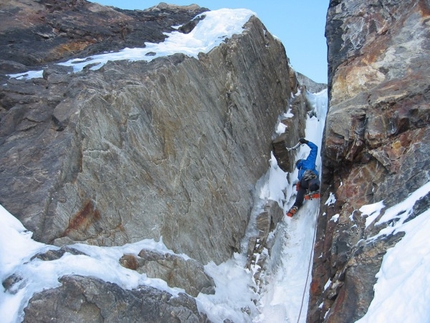
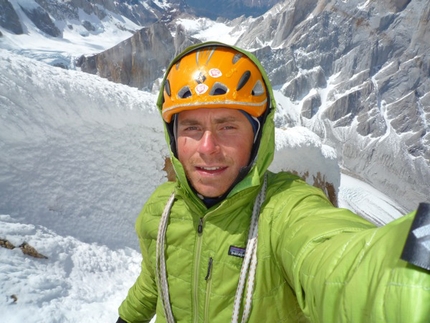
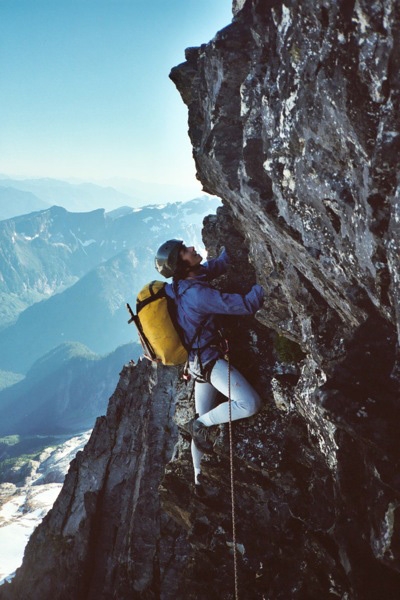
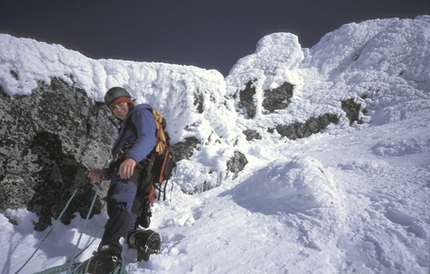
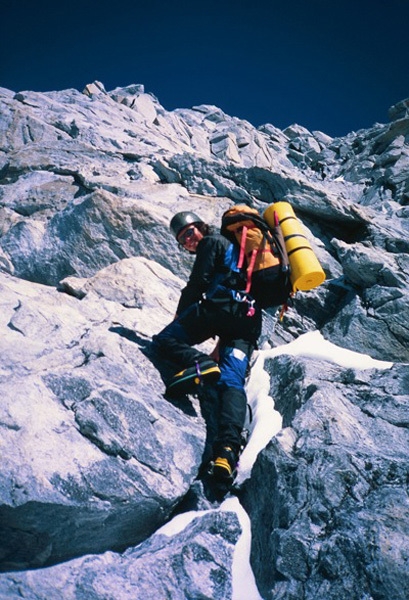
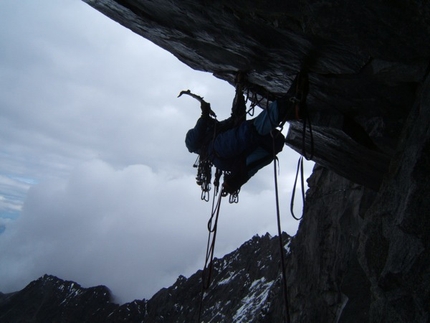
 See all photos
See all photos
